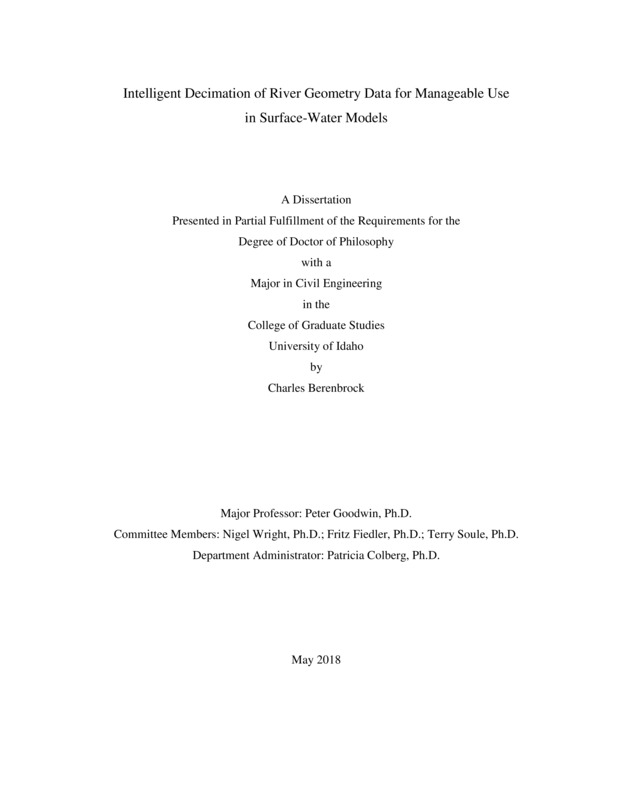Intelligent Decimation of River Geometry Data for Manageable Use in Surface-Water Models
Berenbrock, Charles. (2018-05). Intelligent Decimation of River Geometry Data for Manageable Use in Surface-Water Models. Theses and Dissertations Collection, University of Idaho Library Digital Collections. https://www.lib.uidaho.edu/digital/etd/items/berenbrock_idaho_0089e_11358.html
- Title:
- Intelligent Decimation of River Geometry Data for Manageable Use in Surface-Water Models
- Author:
- Berenbrock, Charles
- Date:
- 2018-05
- Keywords:
- Computational methods Data management Data reduction Decimation Genetic Algorithm Surface Water
- Program:
- Civil Engineering
- Subject Category:
- Civil engineering; Hydraulic engineering; Computer science
- Abstract:
-
Two genetic algorithms (GA) for reducing river geometry data are presented. These algorithms effectively remove “redundant” and/or “nonessential” points from large datasets. The resulting smaller, less dense datasets makes the information more manageable and easier to work with. The first genetic algorithm reduces stream channel cross section data, and the second reduces bathymetry/LiDAR data.
The cross-section genetic algorithm was used to reduce stream channel cross section data. A hypothetical example consisting of 41 data points and 10 cross sections on the Kootenai River in northern Idaho were reduced. Cross sections from the Kootenai River that are representative of meander, straight, braided, and canyon reaches were used to evaluate the reduction methods. The number of data points for the Kootenai River cross sections ranged from about 500 to more than 2,500. Results indicated that the genetic algorithm successfully reduced the data. However, the original genetic algorithm does not account for varying distances between the data points. To account for irregularly-spaced data, the fitness function was modified and used in subsequent analyses. Fitness values from the modified genetic algorithm were lower (better) than in the original genetic algorithm and those that used the standard method of reducing cross-section data. Visual and hydraulic analyses were also used to assess the methods. The genetic algorithm reduced cross sections approximated the shape of the original cross sections better than the standard-reduced cross sections. Also a greater number of cross-sectional data points were needed for reduced cross sections in the straight reach and even more in the meander reach because a greater amount of data points are needed to adequately define cross sections that have greater topographic variability.
The effects of reduced cross-sectional data points on steady flow profiles were also analyzed. A portion of the original steady-flow model of the Kootenai River was used, consisting of thirty-five cross sections. These cross sections were reduced to 10, 20, and 30 data points by the standard and modified genetic algorithm methods, that is, six test were completed for each of the thirty-five cross sections. Differences were smaller for reduced cross sections developed by the genetic algorithm (modified) method than the standard algorithm method. Generally, differences from the original water-surface elevation were smaller as the number of data points in reduced cross sections increased, but not always, especially in the braided reach.
A genetic algorithm to decimate bathymetry and Light Detection and Ranging (LiDAR) datasets was also developed. These datasets can be used in two- and three-dimensional surface-water models. A hypothetical example consisting of 961 regularly spaced data points (x, y, and z) and data taken from an actual bathymetric and LiDAR dataset (10,080 data points) were reduced. Results indicated that the genetic algorithm successfully reduced the data. Terrains produced by the genetic algorithm are fairly representative of the original data and had smaller differences (better) than standard procedures of decimating LiDAR. Hypsometric curves of volume between the GA runs and original dataset were quite similar while the curves from standard reduction methods were quite different than the original.
Other x-y data also can be reduced in a method similar to that for cross section data. Also the LiDAR/bathymetric genetic algorithm should decimate equally as well on any terrain data that is expressed in x, y, and z coordinates.
- Description:
- doctoral, Ph.D., Civil Engineering -- University of Idaho - College of Graduate Studies, 2018-05
- Major Professor:
- Goodwin, Peter
- Committee:
- Wright, Nigel G; Fiedler, Fritz R; Soule, Terrence
- Defense Date:
- 2018-05
- Identifier:
- Berenbrock_idaho_0089E_11358
- Type:
- Text
- Format Original:
- Format:
- application/pdf
- Rights:
- In Copyright - Educational Use Permitted. For more information, please contact University of Idaho Library Special Collections and Archives Department at libspec@uidaho.edu.
- Standardized Rights:
- http://rightsstatements.org/vocab/InC-EDU/1.0/

